Honeywell UDC3200 Operating Manual
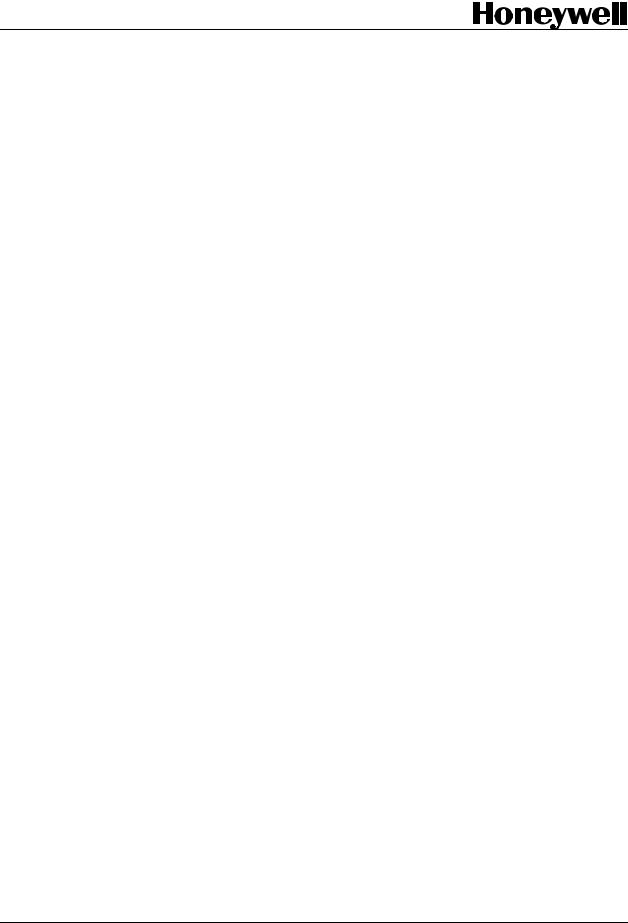
UDC3200
Universal Digital Controller
Product Manual
51-52-25-119 Revision 5 March 2012
Honeywell Process Solutions

Notices and Trademarks
Copyright 2008 by Honeywell
Revision 5 March 2012
While this information is presented in good faith and believed to be accurate, Honeywell disclaims the implied warranties of merchantability and fitness for a particular purpose and makes no express warranties except as may be stated in its written agreement with and for its customers.
In no event is Honeywell liable to anyone for any indirect, special or consequential damages. The information and specifications in this document are subject to change without notice.
Honeywell, PlantScape, Experion PKS, and TotalPlant are registered trademarks of Honeywell International Inc.
Other brand or product names are trademarks of their respective owners.
Honeywell Process Solutions
1860 West Rose Garden Lane
Phoenix, Arizona 85027
ii |
UDC3200 Universal Digital Controller Product Manual |
March 2012 |

About This Document
Abstract
This document provides descriptions and procedures for the Installation, Configuration, Operation, and Troubleshooting of your UDC3200 Controller.
Revision Information
Document Name |
Document ID |
Revision |
Publication Date |
UDC3200 Universal Digital Controller |
|
Number |
|
|
|
|
|
Product Manual |
|
|
|
|
|
|
|
Input Voltage change |
51-52-25-119 |
5 |
March 2012 |
|
|
|
|
|
|
|
|
References
The following list identifies all documents that may be sources of reference for material discussed in this publication.
Document Title
Process Instrument Explorer manual |
51-52-25-131 |
How to Apply Digital Instrumentation in Severe Electrical Noise |
51-52-05-01 |
Environments. |
|
Modbus RTU Serial Communications User Manual |
51-52-25-66 |
MODBUS Messaging on TCP/IP Implementation Guide. |
51-52-25-121 |
March 2012 |
UDC3200 Universal Digital Controller Product Manual |
iii |

Support and Contact info
United States and Canada
Contact: |
Honeywell Process Solution |
|
Global Technical Support - Phone: 001-800-423-9883 |
|
Customer Service (HFS) - Phone: 001-800-343-0228 |
|
Outside United States - Phone: 001-215-641-3610 |
|
Calls are answered by dispatcher between 6:00 am and 4:00 pm Mountain Standard Time. |
|
Emergency calls outside normal working hours are received by an answering service and returned |
|
within one hour. |
Email support: |
ask-ssc@honeywell.com |
Mail: |
Honeywell Process Solutions |
|
1860 West Rose Garden Lane, |
|
Phoenix, Arizona 85027 |
For more contact details for Europe, Asia, North and South Americas, please see back page.
World Wide Web
Honeywell Process Solutions Support Online: www.honeywellprocess.com/
Elsewhere
Call your nearest Honeywell office.
Training Classes
Honeywell Automation College:
http://www.automationcollege.com
iv |
UDC3200 Universal Digital Controller Product Manual |
March 2012 |
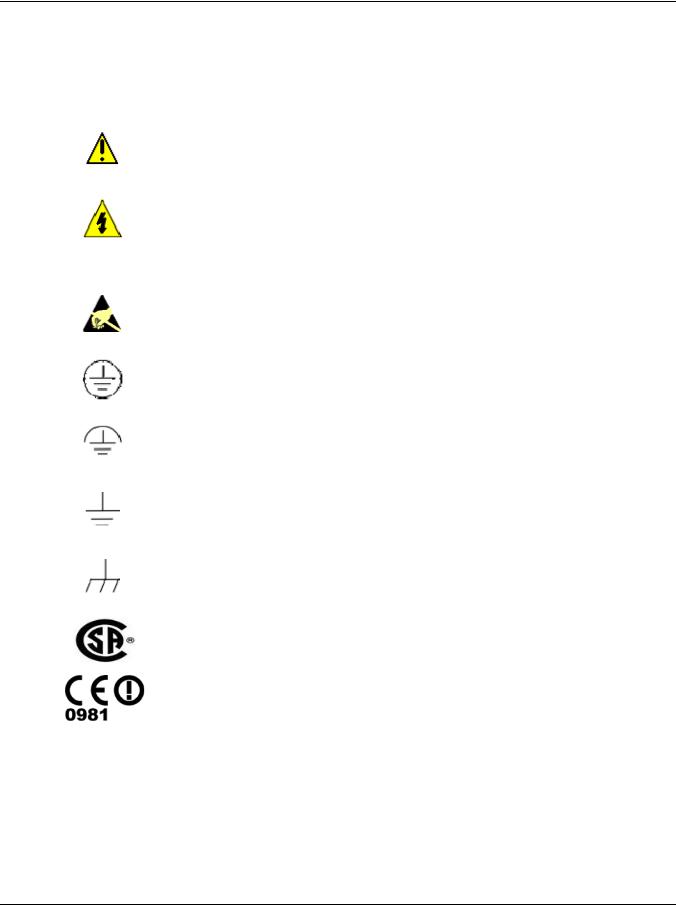
Symbol Definitions
The following table lists those symbols used in this document to denote certain conditions.
Symbol |
Definition |
|
|
|
This CAUTION symbol on the equipment refers the user to the Product Manual for |
|
additional information. This symbol appears next to required information in the |
|
manual. |
|
|
|
WARNING |
|
PERSONAL INJURY: Risk of electrical shock. This symbol warns the user of a |
|
potential shock hazard where HAZARDOUS LIVE voltages greater than 30 Vrms, |
|
42.4 Vpeak, or 60 VDC may be accessible. Failure to comply with these |
|
instructions could result in death or serious injury. |
|
|
|
ATTENTION, Electrostatic Discharge (ESD) hazards. Observe precautions for |
|
handling electrostatic sensitive devices |
|
|
|
Protective Earth (PE) terminal. Provided for connection of the protective earth (green |
|
or green/yellow) supply system conductor. |
|
|
|
Functional earth terminal. Used for non-safety purposes such as noise immunity |
|
improvement. NOTE: This connection shall be bonded to protective earth at the |
|
source of supply in accordance with national local electrical code requirements. |
|
|
|
Earth Ground. Functional earth connection. NOTE: This connection shall be bonded |
|
to Protective earth at the source of supply in accordance with national and local |
|
electrical code requirements. |
|
|
|
Chassis Ground. Identifies a connection to the chassis or frame of the equipment |
|
shall be bonded to Protective Earth at the source of supply in accordance with |
|
national and local electrical code requirements. |
|
|
|
The Canadian Standards mark means the equipment has been tested and meets |
|
applicable standards for safety and/or performance. |
|
|
|
For radio equipment used in the European Union in accordance with the R&TTE |
|
Directive the CE Mark and the notified body (NB) identification number is used when |
|
the NB is involved in the conformity assessment procedure. The alert sign must be |
|
used when a restriction on use (output power limit by a country at certain |
|
frequencies) applies to the equipment and must follow the CE marking. |
|
|
March 2012 |
UDC3200 Universal Digital Controller Product Manual |
v |

|
|
Contents |
|
1 |
INTRODUCTION ................................................................................................... |
1 |
|
1.1 |
|
Overview......................................................................................................................................... |
1 |
1.2 |
|
Operator Interface ........................................................................................................................... |
5 |
|
1.2.1 Function of Displays and Keys ............................................................................................ |
6 |
|
1.3 |
|
Process Instrument Explorer Software............................................................................................ |
7 |
1.4 |
|
CE Conformity (Europe)................................................................................................................. |
8 |
2 |
INSTALLATION................................................................................................... |
11 |
|
2.1 |
|
Overview....................................................................................................................................... |
11 |
2.2 |
|
Condensed Specifications ............................................................................................................. |
12 |
2.3 |
|
Model Number Interpretation ....................................................................................................... |
15 |
2.4 |
|
Control and Alarm Relay Contact Information............................................................................. |
18 |
2.5 |
|
Mounting....................................................................................................................................... |
19 |
2.6 |
|
Wiring ........................................................................................................................................... |
21 |
|
2.6.1 Electrical Considerations ................................................................................................... |
21 |
|
2.7 |
|
Wiring Diagrams........................................................................................................................... |
23 |
3 |
CONFIGURATION............................................................................................... |
37 |
|
3.1 |
|
Overview....................................................................................................................................... |
37 |
3.2 |
|
Configuration Prompt Hierarchy .................................................................................................. |
38 |
3.3 |
|
Configuration Procedure............................................................................................................... |
40 |
3.4 |
|
Tuning Set Up Group.................................................................................................................... |
41 |
3.5 |
|
SP Ramp Set Up Group ................................................................................................................ |
45 |
3.6 |
|
Accutune Set Up Group ................................................................................................................ |
49 |
3.7 |
|
Algorithm Set Up Group............................................................................................................... |
51 |
3.8 |
|
Output Set Up Group .................................................................................................................... |
61 |
3.9 |
|
Input 1 Set Up Group.................................................................................................................... |
65 |
3.10 |
Input 2 Set Up Group ................................................................................................................ |
69 |
|
3.11 |
Control Set Up Group ............................................................................................................... |
72 |
|
3.12 |
Options Group ........................................................................................................................... |
79 |
|
3.13 |
Communications Group ............................................................................................................ |
85 |
|
3.14 |
Alarms Set Up Group ................................................................................................................ |
88 |
|
3.15 |
Display Set Up Group ............................................................................................................... |
93 |
|
3.16 |
Configuration Record Sheet ...................................................................................................... |
95 |
|
vi |
UDC3200 Universal Digital Controller Product Manual |
March 2012 |

4 |
MONITORING AND OPERATING THE CONTROLLER..................................... |
97 |
||
4.1 |
|
Overview....................................................................................................................................... |
97 |
|
4.2 |
|
Operator Interface ......................................................................................................................... |
98 |
|
4.3 |
Entering a Security Code .............................................................................................................. |
98 |
||
4.4 |
|
Lockout Feature ............................................................................................................................ |
99 |
|
4.5 |
|
Monitoring Your Controller........................................................................................................ |
101 |
|
|
4.5.1 |
Annunciators .................................................................................................................... |
101 |
|
|
4.5.2 Viewing the operating parameters.................................................................................... |
102 |
||
|
4.5.3 |
Diagnostic Messages ........................................................................................................ |
103 |
|
4.6 |
Start Up Procedure for Operation ............................................................................................... |
105 |
||
4.7 |
|
Control Modes ............................................................................................................................ |
106 |
|
|
4.7.1 |
Mode Definitions ............................................................................................................. |
106 |
|
|
4.7.2 What happens when you change modes........................................................................... |
107 |
||
4.8 |
|
Setpoints...................................................................................................................................... |
107 |
|
4.9 |
|
Timer |
........................................................................................................................................... |
109 |
4.10 |
Accutune .............................................................................................................................III |
110 |
||
|
4.10.1 ............................................................................................ |
Tune for Simplex Outputs |
111 |
|
|
4.10.2 ....................................................................................... |
Tune for Duplex (Heat/Cool) |
112 |
|
|
4.10.3 ................................. |
Using AUTOMATIC TUNE at start - up for Duplex (Heat/Cool) |
113 |
|
|
4.10.4 ...................................... |
Using BLENDED TUNE at start - up for Duplex (Heat/Cool) |
114 |
|
|
4.10.5 ....................................... |
Using MANUAL TUNE at start - up for Duplex (Heat/Cool) |
114 |
|
|
4.10.6 ................................................................................................................... |
Error Codes |
116 |
|
4.11 |
Fuzzy .................................................................................................Overshoot Suppression |
117 |
||
4.12 |
Using ......................................................................................Two Sets of Tuning Constants |
117 |
||
4.13 |
Alarm .......................................................................................................................Setpoints |
119 |
||
4.14 |
Three ...................................................................................Position Step Control Algorithm |
121 |
||
4.15 |
Setting .............................................a Failsafe Output Value for Restart After a Power Loss |
122 |
||
4.16 |
Setting ..............................................................................................................Failsafe Mode |
123 |
||
4.17 |
Setpoint .................................................................................Rate/Ramp/Program Overview |
123 |
||
4.18 |
Setpoint ...........................................................................................................................Rate |
124 |
||
4.19 |
Setpoint .........................................................................................................................Ramp |
124 |
||
4.20 |
Setpoint .........................................................................................Ramp/Soak Programming |
126 |
||
5 |
INPUT CALIBRATION....................................................................................... |
133 |
5.1 |
Overview..................................................................................................................................... |
133 |
5.2 |
Minimum and Maximum Range Values ..................................................................................... |
134 |
5.3 |
Preliminary Information.............................................................................................................. |
136 |
March 2012 |
UDC3200 Universal Digital Controller Product Manual |
vii |

5.4 |
Input 1 or 2 Set Up Wiring ......................................................................................................... |
137 |
|
|
5.4.1 Thermocouple Inputs Using an Ice Bath.......................................................................... |
137 |
|
|
5.4.2 Thermocouple Inputs Using a Thermocouple Source...................................................... |
138 |
|
|
5.4.3 |
RTD Inputs....................................................................................................................... |
138 |
|
5.4.4 Radiamatic, Millivolts, Volts or Thermocouple Differential Inputs ................................ |
139 |
|
|
5.4.5 0 to 10 Volts..................................................................................................................... |
140 |
|
|
5.4.6 |
Milliamperes .................................................................................................................... |
140 |
5.5 |
Input 1 or 2 Calibration Procedure.............................................................................................. |
141 |
|
5.6 |
Restore Input Factory Calibration............................................................................................... |
142 |
|
6 |
OUTPUT CALIBRATION................................................................................... |
145 |
|
6.1 |
Overview..................................................................................................................................... |
145 |
|
6.2 |
Current Output Calibration ......................................................................................................... |
146 |
|
6.3 |
Auxiliary Output Calibration ...................................................................................................... |
148 |
|
6.4 |
Position Proportional and Three Position Step Output Calibration ............................................ |
150 |
|
6.5 |
Restore Output Factory Calibration ............................................................................................ |
153 |
|
7 |
TROUBLESHOOTING/SERVICE...................................................................... |
155 |
|
7.1 |
Overview..................................................................................................................................... |
155 |
|
7.2 |
Troubleshooting Aids.................................................................................................................. |
156 |
|
7.3 |
Power-up Tests............................................................................................................................ |
158 |
|
7.4 |
Status Tests ................................................................................................................................. |
158 |
|
7.5 |
Background Tests........................................................................................................................ |
159 |
|
7.6 |
Controller Failure Symptoms...................................................................................................... |
160 |
|
7.7 |
Troubleshooting Procedures ....................................................................................................... |
162 |
|
7.8 |
Restoring Factory Configuration ................................................................................................ |
172 |
|
7.9 |
Software Upgrades...................................................................................................................... |
173 |
|
8 |
PARTS LIST ...................................................................................................... |
175 |
|
8.1 |
Exploded View............................................................................................................................ |
175 |
|
8.2 |
Removing the chassis.................................................................................................................. |
177 |
|
9 |
MODBUS RTU FUNCTION CODES.................................................................. |
178 |
|
9.1 |
Overview..................................................................................................................................... |
178 |
|
9.2 |
General Information.................................................................................................................... |
178 |
|
9.3 |
Function Code 20 (14h) - Read Configuration Reference Data.................................................. |
180 |
|
|
9.3.1 |
Read Configuration Examples ......................................................................................... |
182 |
9.4 |
Function Code 21 (15h) - Write Configuration Reference Data................................................. |
184 |
|
|
9.4.1 |
Write Configuration Examples ........................................................................................ |
186 |
viii |
UDC3200 Universal Digital Controller Product Manual |
March 2012 |

10 MODBUS READ, WRITE AND OVERRIDE PARAMETERS PLUS EXCEPTION
CODES |
........................................................................................................................ |
|
187 |
10.1 |
Overview ................................................................................................................................. |
187 |
|
10.2 |
Reading Control Data.............................................................................................................. |
188 |
|
10.3 |
Read Software Options Status................................................................................................. |
189 |
|
10.4 |
Miscellaneous Read Onlys ...................................................................................................... |
190 |
|
10.4.1 |
Register Addresses for Read Onlys .............................................................................. |
190 |
|
10.4.2 |
SetPoint Program Read Only Information.................................................................... |
190 |
|
10.5 |
Setpoints .................................................................................................................................. |
191 |
|
10.6 |
Using a Computer Setpoint (Overriding Controller Setpoint) ................................................ |
192 |
|
10.7 |
Configuration Parameters........................................................................................................ |
194 |
|
10.7.1 |
Tuning .......................................................................................................................... |
194 |
|
10.7.2 |
SP Ramp/Rate/Program................................................................................................ |
196 |
|
10.7.3 |
Accutune....................................................................................................................... |
199 |
|
10.7.4 |
Algorithm ..................................................................................................................... |
200 |
|
10.7.5 |
Output Algorithms........................................................................................................ |
203 |
|
10.7.6 |
Input 1........................................................................................................................... |
205 |
|
10.7.7 |
Input 2........................................................................................................................... |
208 |
|
10.7.8 |
Control.......................................................................................................................... |
211 |
|
10.7.9 |
Options ......................................................................................................................... |
214 |
|
10.7.10 |
Communications........................................................................................................... |
217 |
|
10.7.11 |
Alarms .......................................................................................................................... |
218 |
|
10.7.12 |
Display.......................................................................................................................... |
220 |
|
10.8 |
Modbus RTU Exception Codes............................................................................................... |
221 |
|
11 |
ETHERNET TCP/IP ........................................................................................... |
223 |
|
|
11.1 |
Overview ................................................................................................................................. |
223 |
12 |
FURTHER INFORMATION................................................................................ |
224 |
|
|
12.1 |
Modbus RTU Serial Communications .................................................................................... |
224 |
|
12.2 |
Modbus Messaging on TCP/IP................................................................................................ |
224 |
|
12.3 |
How to Apply Digital Instrumentation in Severe Electrical Noise Environments.................. |
224 |
13 |
INDEX................................................................................................................ |
225 |
|
14 |
SALES AND SERVICE...................................................................................... |
229 |
|
March 2012 |
UDC3200 Universal Digital Controller Product Manual |
ix |

Tables
Table 2-1 Condensed Specifications ____________________________________________________ 12 Table 2-2 Control Relay Contact Information _____________________________________________ 18 Table 2-3 Alarm Relay Contact Information ______________________________________________ 18 Table 2-4 Mounting Procedure_________________________________________________________ 20 Table 2-5 Permissible Wiring Bundling__________________________________________________ 22 Table 2-6 Universal Output Functionality and Restrictions ___________________________________ 24 Table 2-7 Terminals for connecting a UDC to a MDI Compliant Hub or Switch __________________ 35 Table 2-8 Terminals for connecting a UDC directly to a PC utilizing a straight-through cable ________ 35 Table 3-1 Configuration Topics ________________________________________________________ 37 Table 3-2 Configuration Prompt Hierarchy _______________________________________________ 38 Table 3-3 Configuration Procedure _____________________________________________________ 40 Table 3-4 TUNING Group Function Prompts _____________________________________________ 41 Table 3-5 SPRAMP Group Function Prompts _____________________________________________ 45 Table 3-6 ACCUTUNE Group Function Prompts __________________________________________ 49 Table 3-7 ALGORTHM Group Function Prompts _________________________________________ 51 Table 3-8 OUTPUT Group Function Prompts _____________________________________________ 61 Table 3-9 INPUT 1 Group Function Prompts _____________________________________________ 65 Table 3-10 INPUT 2 Group Function Prompts ____________________________________________ 69 Table 3-11 CONTROL Group Function Prompts ___________________________________________ 72 Table 3-12 OPTION Group Function Prompts ____________________________________________ 79 Table 3-13 Communications Group Function Prompts ______________________________________ 85 Table 3-14 ALARMS Group Function Prompts ___________________________________________ 88 Table 3-15 DISPLAY Group Function Prompts ___________________________________________ 93 Table 4-1 Procedure to Enter a Security Code _____________________________________________ 99 Table 4-2 Annunciators _____________________________________________________________ 101 Table 4-3 Lower Display Key Parameter Prompts_________________________________________ 102 Table 4-4 Diagnostic Messages________________________________________________________ 103 Table 4-5 Procedure for Starting Up the Controller ________________________________________ 105 Table 4-6 Control Mode Definitions ___________________________________________________ 106 Table 4-7 Changing Control Modes ____________________________________________________ 107 Table 4-8 Procedure for Changing the Local Setpoints _____________________________________ 108 Table 4-9 Procedure for Switching Between Setpoints _____________________________________ 108 Table 4-10 Procedure for Starting “TUNE” ______________________________________________ 111 Table 4-11 Procedure for Using AUTOMATIC TUNE at Start-up for Duplex Control ____________ 113 Table 4-12 Procedure for Using BLENDED TUNE at Start-up for Duplex Control_______________ 114 Table 4-13 Procedure for Using MANUAL TUNE for Heat side of Duplex Control ______________ 114 Table 4-14 Procedure for Using MANUAL TUNE for Cool side of Duplex Control ______________ 115 Table 4-15 Procedure for Accessing Accutune Error Codes _________________________________ 116 Table 4-16 Accutune Error Codes _____________________________________________________ 116 Table 4-17 Set Up Procedure _________________________________________________________ 118 Table 4-18 Procedure for Switching PID SETS from the Keyboard ___________________________ 119 Table 4-19 Procedure for Displaying Alarm Setpoints _____________________________________ 120 Table 4-20 Procedure for Displaying 3Pstep Motor Position_________________________________ 121 Table 4-21 Procedure for Setting a Failsafe Value_________________________________________ 122 Table 4-22 Procedure for Setting a Failsafe Mode_________________________________________ 123 Table 4-23 Running A Setpoint Ramp __________________________________________________ 125 Table 4-24 Program Contents_________________________________________________________ 127 Table 4-25 Run/Monitor Functions ____________________________________________________ 131
x |
UDC3200 Universal Digital Controller Product Manual |
March 2012 |

Table 5-1 Voltage, Milliamp and Resistance Equivalents for Input Range Values _______________ 134 Table 5-2 Equipment Needed_________________________________________________________ 136 Table 5-3 Set Up Wiring Procedure for Thermocouple Inputs Using an Ice Bath ________________ 137 Table 5-4 Set Up Wiring Procedure for Thermocouple Inputs using Thermocouple Source ________ 138 Table 5-5 Set Up Wiring Procedure for RTD Inputs _______________________________________ 138 Table 5-6 Set Up Wiring Procedure for Radiamatic, Millivolts, Volts or Thermocouple Differential Inputs
(Except 0-10 Volts) _____________________________________________________________ 139 Table 5-7 Set Up Wiring Procedure for 0 to 10 Volts ______________________________________ 140 Table 5-8 Set Up Wiring Procedure for Milliampere Inputs _________________________________ 140 Table 5-9 Input 1 or 2 Calibration Procedure _____________________________________________ 141 Table 5-10 Restore Factory Calibration _________________________________________________ 143 Table 6-1 Set Up Wiring Procedure for Current Output ____________________________________ 146 Table 6-2 Current Output Calibration Procedure __________________________________________ 147 Table 6-3 Set Up Wiring Procedure for Auxiliary Output ___________________________________ 148 Table 6-4 Auxiliary Output Calibration Procedure ________________________________________ 149 Table 6-5 Position Proportional and Three Position Step Output Calibration Procedure ___________ 150 Table 6-6 Restore Factory Calibration __________________________________________________ 153 Table 7-1 Procedure for Identifying the Software Version __________________________________ 157 Table 7-2 Procedure for Displaying the Status Test Results _________________________________ 158 Table 7-3 Background Tests__________________________________________________________ 159 Table 7-4 Controller Failure Symptoms_________________________________________________ 161 Table 7-5 Troubleshooting Power Failure Symptoms ______________________________________ 163 Table 7-6 Troubleshooting Current Output Failure ________________________________________ 163 Table 7-7 Troubleshooting Position Proportional Output Failure _____________________________ 164 Table 7-8 Troubleshooting Time Proportional Output Failure _______________________________ 165 Table 7-9 Troubleshooting Current/Time or Time/Current Proportional Output Failure ___________ 166 Table 7-10 Troubleshooting Alarm Relay Output Failure ___________________________________ 167 Table 7-11 Troubleshooting a Keyboard Failure __________________________________________ 168 Table 7-12 Troubleshooting a RS-485 Communications Failure______________________________ 169 Table 7-13 Troubleshooting an Ethernet Communications Failure ___________________________ 170 Table 7-14 Troubleshooting Auxiliary Output Failure _____________________________________ 171 Table 7-15 Restoring Factory Configuration _____________________________________________ 172 Table 7-16 Software Upgrades________________________________________________________ 173 Table 8-1 Parts Identification _________________________________________________________ 176 Table 8-2 Parts Not Shown___________________________________________________________ 176 Table 8-3 Software Upgrades (see Section 7.9) ___________________________________________ 176 Table 9-1 Integer Parameter Type _____________________________________________________ 179 Table 9-2 Floating Point Parameter Type________________________________________________ 179 Table 9-3 Register Address Format for Function Code 20___________________________________ 181 Table 9-4 Register Address Format for Function Code 21___________________________________ 185 Table 10-1 Control Data Parameters ___________________________________________________ 189 Table 10-2 Option Status ____________________________________________________________ 189 Table 10-3 Miscellaneous Read Onlys__________________________________________________ 190 Table 10-4 SetPoint Program Read Only Information ______________________________________ 190 Table 10-5 Setpoint Code Selections ___________________________________________________ 191 Table 10-6 Setpoint Associated Parameters ______________________________________________ 192 Table 10-7 Computer Setpoint Selection ________________________________________________ 192 Table 10-8 Computer Setpoint Associated Parameters _____________________________________ 193 Table 10-9 Set-up Group – Tuning ____________________________________________________ 194 Table 10-10 Set-up Group – Setpoint Ramp/Rate _________________________________________ 196
March 2012 |
UDC3200 Universal Digital Controller Product Manual |
xi |

Table 10-11 Set-up Group – Adaptive Tune _____________________________________________ 199 Table 10-12 Set-up Group – Algorithm _________________________________________________ 200 Table 10-13 Set-up Group – Output____________________________________________________ 203 Table 10-14 Set-up Group – Input 1____________________________________________________ 205 Table 10-15 Set-up Group – Input 2____________________________________________________ 208 Table 10-16 Set-up Group – Control ___________________________________________________ 211 Table 10-17 Set-up Group – Options ___________________________________________________ 214 Table 10-18 Set-up Group – Communications____________________________________________ 217 Table 10-19 Set-up Group – Alarms ___________________________________________________ 218 Table 10-20 Set-up Group – Display ___________________________________________________ 220 Table 10-21 Modbus RTU Data Layer Status Exception Codes ______________________________ 222
xii |
UDC3200 Universal Digital Controller Product Manual |
March 2012 |

Figures
Figure 1-1 UDC3200 Operator Interface __________________________________________________ 5 Figure 1-2 Screen capture of Process Instrument Explorer running on a Pocket PC _________________ 7 Figure 1-3 Depiction of infrared communications ___________________________________________ 8 Figure 2-1 Model Number Interpretation _________________________________________________ 15 Figure 2-2 Mounting Dimensions (not to scale)____________________________________________ 19 Figure 2-3 Mounting Methods _________________________________________________________ 20 Figure 2-4 Composite Wiring Diagram __________________________________________________ 25 Figure 2-5 Mains Power Supply________________________________________________________ 26 Figure 2-6 Input 1 Connections_________________________________________________________ 27 Figure 2-7 Input 2 Connections_________________________________________________________ 28 Figure 2-8 Electromechanical Relay Output _______________________________________________ 29 Figure 2-9 Solid State Relay Output _____________________________________________________ 30 Figure 2-10 Open Collector Output______________________________________________________ 31 Figure 2-11 Dual Electromechanical Relay Option Output ___________________________________ 32 Figure 2-12 Current Output____________________________________________________________ 32 Figure 2-13 Position Proportional or Three Position Step Control Connections w/o Dual Relay Option 33 Figure 2-14 Position Proportional or Three Position Step Control Connections with Dual Relay Option 33 Figure 2-15 RS-422/485 Communications Option Connections________________________________ 34 Figure 2-16 Ethernet Communications Option Connections___________________________________ 34 Figure 2-17 Auxiliary Output and Digital Inputs Option Connections ___________________________ 35 Figure 2-18 Transmitter Power for 4-20 mA — 2 wire Transmitter Using Open Collector Alarm 2 Output36 Figure 2-19 Transmitter Power for 4-20 mA — 2 Wire Transmitter Using Auxiliary Output ________ 36 Figure 3-1 Mass Flow Example ________________________________________________________ 59 Figure 4-1 Operator Interface__________________________________________________________ 98 Figure 4-2 Functional Overview Block Diagram of the UDC3200 Controller ___________________ 104 Figure 4-3 Ramp/Soak Profile Example_________________________________________________ 129 Figure 4-4 Program Record Sheet _____________________________________________________ 130 Figure 5-1 Input 1 and Input 2 Wiring Terminals _________________________________________ 136 Figure 5-2 Wiring Connections for Thermocouple Inputs Using an Ice Bath ____________________ 137 Figure 5-3 Wiring Connections for Thermocouple Inputs Using Thermocouple Source ___________ 138 Figure 5-4 Wiring Connections for RTD (Resistance Thermometer Device) ____________________ 138 Figure 5-5 Wiring Connections for Radiamatic, Thermocouple Differential, Millivolts or Volts (Except 0 to 10
Volts) ________________________________________________________________________ 139 Figure 5-6 Wiring Connections for 0 to 10 Volts__________________________________________ 140 Figure 5-7 Wiring Connections for 0 to 20 mA or 4 to 20 mA Inputs__________________________ 140 Figure 6-1 Wiring Connections for Calibrating Current Proportional Output ____________________ 146 Figure 6-2 Wiring Connections for Calibrating Auxiliary Output_____________________________ 148 Figure 8-1 UDC3200 Exploded View __________________________________________________ 175 Figure 10-1 Software Option Status Information __________________________________________ 189
March 2012 |
UDC3200 Universal Digital Controller Product Manual |
xiii |

Introduction
1 Introduction
1.1 Overview
Function
The UDC3200 is a microprocessor-based stand-alone controller. It combines a high degree of functionality and operating simplicity in a 1/4 DIN size controller. This instrument is an ideal controller for regulating temperature and other process variables in numerous heating and cooling applications, as well as in metal working, food, pharmaceuticals, semiconductor, testing and environmental work.
The UDC3200 monitors and controls temperatures and other variables in applications such as environmental chambers, plastic processing machines, furnaces and ovens, and packaging machinery.
Features
2 Universal Analog Inputs
0.20% Accuracy
Fast scanning rate (166ms)
Up to 5 Analog and Digital Output Types
2 Digital Inputs
Math Functions
Ethernet and Modbus communication
Infrared PC & Pocket PC configuration
NEMA4X and IP66 front face protection
Multilanguage prompts
¼ DIN Size
Jumper free configuration
Easily Field Upgradable
Easy to read displays
Bright, dual displays with multi-language prompts (in English, French, German, Spanish, or Italian) make the operator interface easy to read, understand, and operate. Simple keystrokes let you set operating parameters that meet your process control needs.
March 2012 |
UDC3200 Universal Digital Controller Product Manual |
1 |

Introduction
Analog Inputs
The UDC3200 has two analog inputs with a typical accuracy of ±0.20% of full-scale input and a typical resolution of 16 bits. Both analog inputs are sampled six times per second (every 166 ms).
The first, or Process Variable input, can be one of the various thermocouple, RTD, Radiamatic or linear actuations. Linear actuations have thermocouple, RTD, and Radiamatic transmitter characterization capability as a standard feature. Linear actuations also have square root capability.
The optional second input is isolated and accepts the same actuations as input one, or it provides the Slidewire input for Position Proportional control.
All actuations and characterizations are keyboard configurable. Cold junction compensation is provided for thermocouple type inputs. Upscale, downscale or failsafe sensor break protection is keyboard configurable. A configurable digital filter of 0 to 120 seconds provides input signal damping.
Thermocouple Health - In addition to the standard configurable upscale, downscale or failsafe output burnout selections, the condition of the thermocouple can be monitored to determine if it is good, failing or in danger of imminent failure.
Math Functions
Algorithm—A pre-configured algorithm is available for easy implementation. This includes the capability of using a Ratio and Bias with any input. You can select from the following menu:
Feedforward Summer—Uses either input, followed by a Ratio/Bias calculation, summed directly with the computed PID output value to provide a resultant output to the final control element (standard feature).
Weighted Average —Computes the weighted average of a PV or SP for the control algorithm from two inputs (standard feature).
Feedforward Multiplier—Uses any input, multiplied by the calculated PID output to provide a resultant output which is sent to the final control element (standard feature).
Summer/Subtractor—Will add or subtract inputs with the result used as the derived PV.
Multiplier/Divider—Uses the analog inputs to calculate a derived PV. Available with or without Square Root.
Input High/Low Select—Specifies the PV input as the higher or lower of the two inputs.
Digital Inputs
Two isolated digital inputs are provided for remote dry contact closure to select one of 25 actions. Also, the digital inputs can allow one of six selections to be combined with one of the above selections.
2 |
UDC3200 Universal Digital Controller Product Manual |
March 2012 |

Introduction
Outputs
Output Types - The UDC3200 may have up to five of the following outputs:
Current Outputs (4-20 or 0-20 ma)
Electromechanical Relays (5 amps)
Solid State Relays (1 amp)
Dual Electromechanical Relays (2 amps)
Open Collector Outputs
Alarms
One or two electromechanical alarm relays are available to activate external equipment when preset alarm setpoints are reached. Each of the two alarms can be set to monitor two independent setpoints. Each alarm setpoint can be either high or low alarm. The alarm type can be selected to be either of the inputs, the Process Variable, Deviation, Output, Shed from communications, PV rate of change, or to alarm on manual mode activation or a Current Output Open failure. It can also be used as an On or Off event at the beginning or end of a Ramp/Soak segment. The alarm hysteresis is configurable from 0 to 100% of range.
Alarms can be configured as latching or non-latching.
Alarm blocking is also available which allows start-up without alarm energized until after it first reaches the operating region.
PV rate of change alarm.
Loop break alarm.
Timer output reset.
Diagnostic Alarm
Communications
A communications link is provided between the UDC3200 and a host computer or PLC via the RS422/485 Modbus® RTU or Ethernet TCP/IP communications option. An infrared communication link is also available allowing a non-intrusive configuration of the instrument.
Miscellaneous Features
Auxiliary Output*(optional) - Either or both of the two current outputs can function as an Auxiliary Output which can be scaled from 4-20 ma for 0 to 100% for any range. It can be configured to represent Input 1, Input 2, PV, active Setpoint, Local SP1, Deviation, or the Control Output.
Transmitter Power - This output provides up to 30 volts dc to power a 2-wire transmitter (it requires the use of alarm 2 open collector output selection or the second current output).
March 2012 |
UDC3200 Universal Digital Controller Product Manual |
3 |

Introduction
Three Local and one Remote Setpoints - Can be configured to provide three Local and one Remote Setpoints, which are selectable either via the keyboard or by Digital Input.
Universal Switching Power - Operates on any line voltage from 90 to 250 Vac 50/60 Hz without jumpers. 24 Vac/dc instrument power is available as an option.
Timer - This standard feature provides a configurable time period of 0 to 99 hours, 59 minutes or units of minutes and seconds. It can be started via the keyboard, alarm 2, or by a digital input. The timer output is Alarm 1, which energizes at the end of the Timer Period. Alarm 1 can be automatically reset. The Timer Period can be changed between each batch. Status is shown on the lower display.
Moisture Protection - The NEMA4X and IP66 rated front face permits use in applications where it may be subjected to moisture, dust, or hose-down conditions.
Setpoint Ramp/Soak Programming (Optional) - Enables you to program and store six Ramp and six Soak segments for setpoint programming. Run or Hold of program is keyboard or remote digital switch selectable.
Setpoint Rate - Lets you define a ramp rate to be applied to any local setpoint change. A separate upscale or downscale rate is configurable. A single setpoint ramp is also available as an alternative.
CE Mark - Conformity with 73/23/EEC, Low Voltage Directive and 89/336/EEC, the EMC Directive as a standard feature.
Approval Body Options - CSA certification is available as an option. UL listing is standard.
Two Sets of Tuning Constants - Two sets of PID parameters can be configured for each loop and automatically or keyboard selected.
Data Security - Five levels of keyboard security protect tuning, configuration, and calibration data, accessed by a configurable 4-digit code. Nonvolatile EEPROM memory assures data integrity during loss of power.
Diagnostic/Failsafe Outputs - Continuous diagnostic routines detect failure modes, trigger a failsafe output value and identify the failure to minimize troubleshooting time.
High Noise Immunity - The controller is designed to provide reliable, error-free performance in industrial environments that often affect highly noise-sensitive digital equipment.
Accutune III™ - This standard feature provides a truly plug and play tuning algorithm, which will, at the touch of a button or through a digital input, accurately identify and tune any process including those with deadtime and integrating processes. This speeds up and simplifies start-up plus allows retuning at any setpoint. The algorithm used is an improved version of the Accutune IITM algorithm found on earlier controllers. Two possibilities are now offered when tuning your process: Fast Tune and Slow Tune.
Fast Tune will tune the process in such a way that the temp is reached faster, a slight overshoot will be allowed.
4 |
UDC3200 Universal Digital Controller Product Manual |
March 2012 |

Introduction
Slowtune will minimize overshoot, but it will take more time for the process temperature to reach the target setpoint.
Heat/Cool (Duplex Tune) will automatically tune both the heating and cooling sides of the process.
Fuzzy Logic - This standard feature uses fuzzy logic to suppress process variable overshoot due to SP changes or externally induced process disturbances. It operates independently from Accutune III tuning. It does not change the PID constants, but temporarily modifies the internal controller response to suppress overshoot. This allows more aggressive tuning to co-exist with smooth PV response. It can be enabled or disabled depending on the application or the control criteria.
1.2 Operator Interface
Figure 1-1 UDC3200 Operator Interface
March 2012 |
UDC3200 Universal Digital Controller Product Manual |
5 |
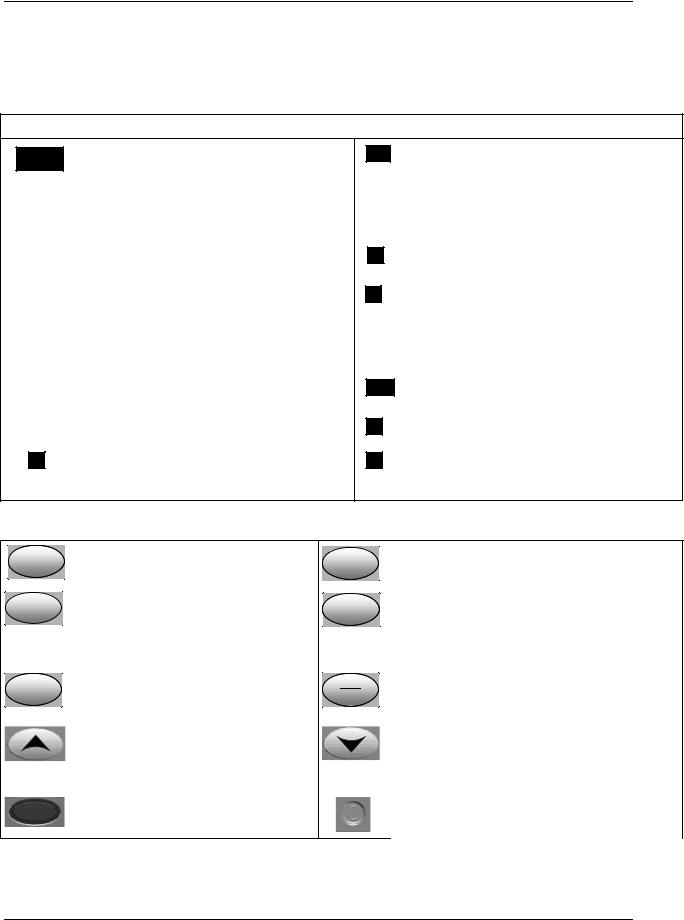
Introduction
1.2.1 Function of Displays and Keys
Table 1-1 Function of Displays and Keys
Display Indicators
3200 |
Upper display with 4 larger digits shows |
Process Variable value (normal operation) |
|
|
and special annunciator features. During |
|
Configuration, the upper display provides |
|
guidance for the operator through prompts (7 |
|
– characters) |
|
|
|
|
During normal operation, the lower display |
SP |
||||
|
|
|
|
shows key-selected operating parameters |
|
|
|
|
|
|
|
|
|
such as Output, Setpoints, Inputs, Deviation, |
|
|
|
|
active Tuning Parameter Set, Timer Status, or |
|
|
|
|
minutes remaining in a setpoint ramp (4 |
|
|
|
|
digits). During configuration, the lower display |
|
|
|
|
provides guidance for the operator through |
|
|
|
|
prompts (8-characters). |
|
|
|
|
Indicates Alarm 1 and/or Alarm 2 conditions |
|
ALM |
|
||
|
|
|
|
exist. |
|
|
|
|
|
|
|
|
Indicates Digital Input 1 and/or 2 on. |
|
|
|
DI |
|
|
OUT Indicates Control Relay 1 and/or 2 on.
|
F |
|
|
Or |
Indicates either degrees Fahrenheit or |
||
|
|
Centigrade. |
|
|
C |
|
|
MAN
Or |
Indicates either Manual or Auto mode. |
|
A |
|
|
|
Indicates Local Setpoint #1. Also, a bar is |
|
SP |
|
|
|
|
lighted when the setpoint being used is shown |
|
|
on the lower display. |
Keys and Functions
Function
Setup
Lower
Display
Selects functions within each configuration group.
Scrolls through the configuration groups.
Returns Controller to normal display from Set Up mode. Toggles various operating parameters for display.
Increases setpoint or output value. Increases the configuration values or changes functions in Configuration mode groups.
Infrared transceiver
Man
Auto
SP
Select
Run
Hold
Selects Manual or Auto mode.
Hold key down to cycle through configured setpoints.
Enables Run/Hold of the SP Ramp or Program plus Timer start.
Decreases setpoint or output value. Decreases the configuration values or changes functions in Configuration mode groups.
NEMA4X and IP66 screw attachment (each corner)
6 |
UDC3200 Universal Digital Controller Product Manual |
March 2012 |
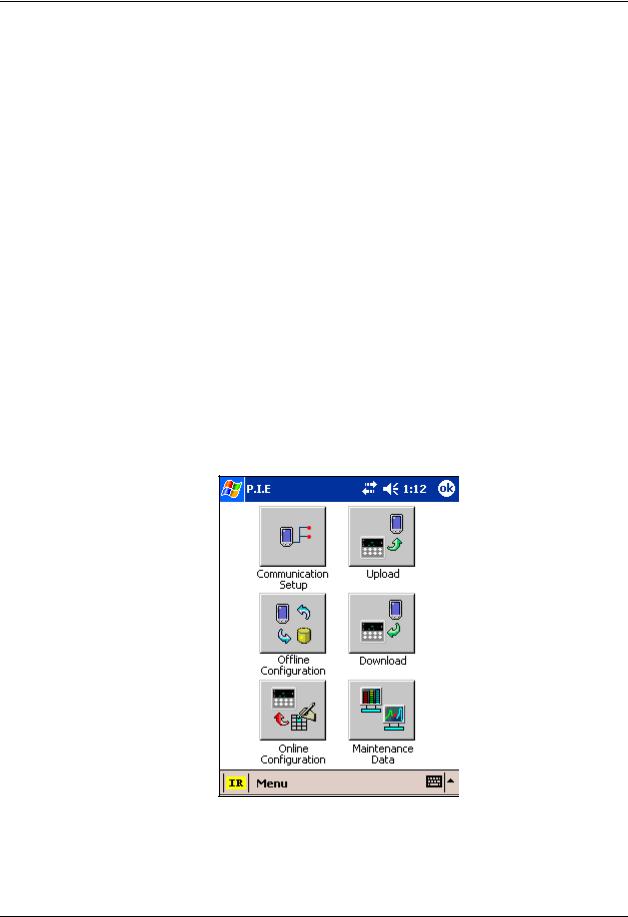
Introduction
1.3 Process Instrument Explorer Software
Overview
Process Instrument Explorer lets you configure your instrument on a desktop/laptop or Pocket PC. For details see Process Instrument Explorer manual #51-52-25-131.
Features
Create configurations with intuitive software program running on a Pocket PC, a Desktop or a laptop computer.
Create/edit configurations live, just connect software to the controller via a communications port.
Create/edit configurations offline and download to controller later via a communications port.
Communication types available on every UDC3200:
o Infrared (standard) o RS 485(optional)
oEthernet (optional)
Same port types on UDC2500 and UDC3500 allow interconnectivity.
This software is available in English, Spanish, Italian, German and French.
Figure 1-2 Screen capture of Process Instrument Explorer running on a Pocket PC
March 2012 |
UDC3200 Universal Digital Controller Product Manual |
7 |
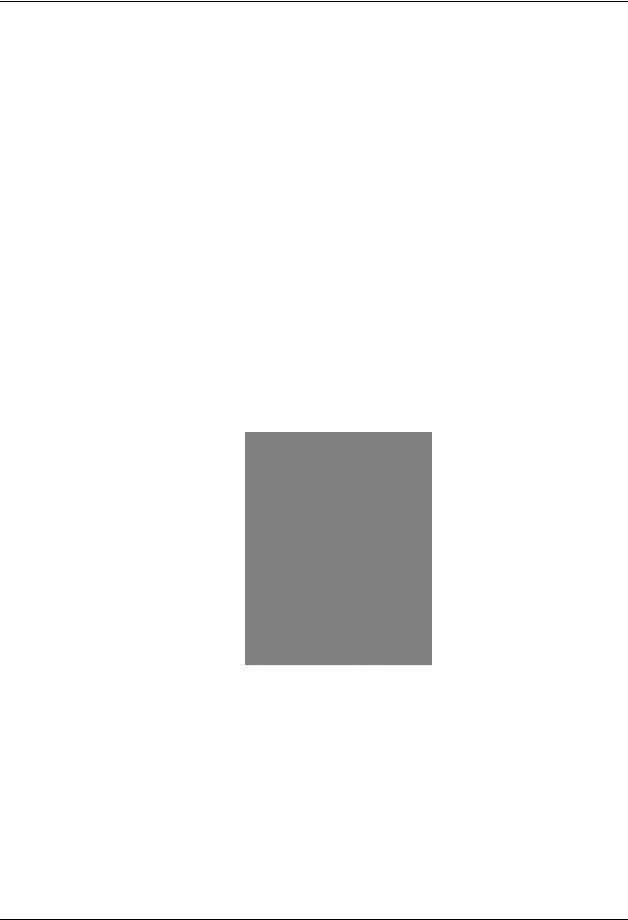
Introduction
Infrared communications
The infrared connection provides a non-intrusive wireless connection with the instrument and maintains NEMA4X AND IP66 integrity.
No need to get access to the back of the controller to communicate with the instrument, no need to take your screw driver to wire the communication cable, no wiring mistake possible. You can now duplicate an instrument’s configuration, upload or download a new configuration in a matter of seconds, just by pointing your Pocket PC in the direction of the instrument.
It takes just a few seconds to upload a configuration from an instrument. You can then save the configuration file onto your PC or pocket PC for review, modification or archiving. Furthermore, this software also gives you important maintenance information on the controller: instantly, get information on the current operating parameters, digital inputs and alarm status, identify internal or analog input problems.
Question: What if I have several controllers on the same panel? How can I be sure I am communicating with the correct one?
Answer: The infrared port of the controller is normally “off”. You activate the infrared port by pressing any controller’s key. You can now communicate. After 4 minutes, the port will be shut down again. Each controller may also be assigned a different communications address.
Figure 1-3 Depiction of infrared communications
1.4 CE Conformity (Europe)
This product is in conformity with the protection requirements of the following European Council Directives: 73/23/EEC, the Low Voltage Directive, and 89/336/EEC, the EMC Directive. Conformity of this product with any other “CE Mark” Directive(s) shall not be assumed.
Product Classification: Class I: Permanently connected, panel-mounted Industrial Control Equipment with protective earthing (grounding) (EN61010-1).
8 |
UDC3200 Universal Digital Controller Product Manual |
March 2012 |
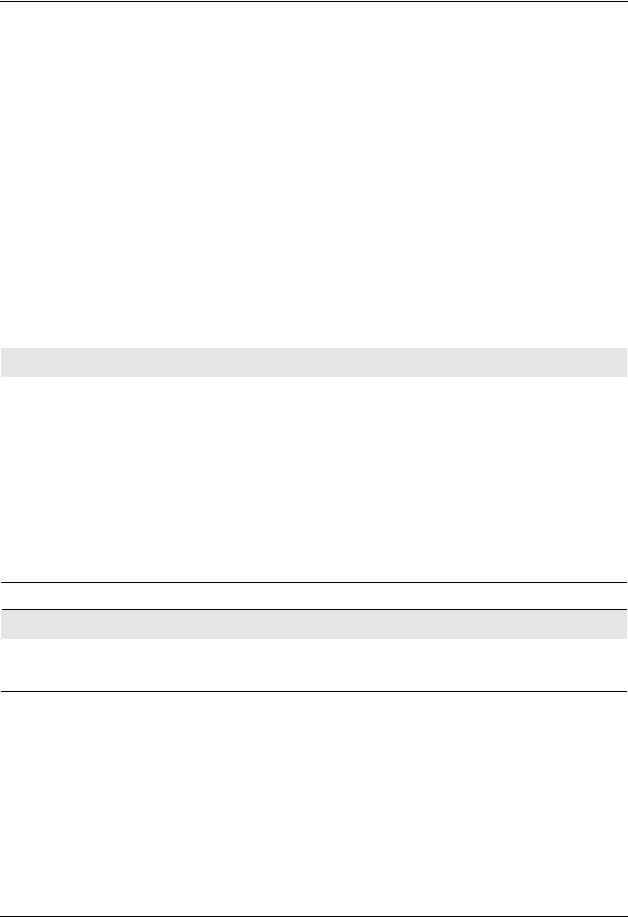
Introduction
Enclosure Rating: This controller must be panel-mounted with the rear terminals enclosed within the panel. The front panel of the controller is rated at NEMA4X and IP66 when properly installed.
Installation Category (Overvoltage Category): Category II (EN61010-1)
Pollution Degree: Pollution Degree 2: Normally non-conductive pollution with occasional conductivity caused by condensation. (Ref. IEC 664-1)
EMC Classification: Group 1, Class A, ISM Equipment (EN61326, emissions), Industrial Equipment (EN61326, immunity)
Method of EMC Assessment: Technical File (TF) Declaration of Conformity: 51453663
Deviation from the installation conditions specified in this manual, and the special conditions for CE conformity in Subsection 2.1, may invalidate this product’s conformity with the Low Voltage and EMC Directives.
ATTENTION
The emission limits of EN61326 are designed to provide reasonable protection against harmful interference when this equipment is operated in an industrial environment. Operation of this equipment in a residential area may cause harmful interference. This equipment generates, uses, and can radiate radio frequency energy and may cause interference to radio and television reception when the equipment is used closer than 30 meters (98 feet) to the antenna(e). In special cases, when highly susceptible apparatus is used in close proximity, the user may have to employ additional mitigating measures to further reduce the electromagnetic emissions of this equipment.
WARNING
If this equipment is used in a manner not specified by the manufacturer, the protection provided by the equipment may be impaired.
March 2012 |
UDC3200 Universal Digital Controller Product Manual |
9 |

Installation
2 Installation
2.1 Overview
Introduction
Installation of the UDC3200 consists of mounting and wiring the controller according to the instructions given in this section. Read the pre-installation information, check the model number interpretation (Subsection 2.3), and become familiar with your model selections, then proceed with installation.
What’s in this section?
The following topics are covered in this section.
|
TOPIC |
See Page |
2.1 |
Overview |
11 |
|
|
|
2.2 |
Condensed Specifications |
12 |
|
|
|
2.3 |
Model Number Interpretation |
15 |
|
|
|
2.4 |
Control and Alarm Relay Contact Information |
18 |
|
|
|
2.5 |
Mounting |
19 |
|
|
|
2.6 |
Wiring |
21 |
|
|
|
2.7 |
Wiring Diagrams |
23 |
|
Composite Wiring Diagram |
25 |
|
AC Line Voltage |
26 |
|
Input 1 Connections |
27 |
|
Input 2 Connections |
28 |
|
Relay Output |
|
|
Electromechanical |
29 |
|
Solid State |
30 |
|
Open Collector |
31 |
|
Dual Electromechanical Relay |
32 |
|
Current Output Connections |
32 |
|
Three Position Step Control Connections w/o Dual Relay |
33 |
|
Three Position Step Control Connections with Dual Relay |
33 |
|
RS-422/485 Communications Option |
34 |
|
Ethernet Communications Option |
34 |
|
Auxiliary Output and Digital Inputs Option |
35 |
|
Transmitter Power using Open Collector Output |
36 |
|
Transmitter Power using Auxiliary Output |
36 |
|
|
|
March 2012 |
UDC3200 Universal Digital Controller Product Manual |
11 |

Installation
Pre-installation Information
If the controller has not been removed from its shipping carton, inspect the carton for damage then remove the controller.
Inspect the unit for any obvious shipping damage and report any damage due to transit to the carrier.
Make sure a bag containing mounting hardware is included in the carton with the controller.
Check that the model number shown on the inside of the case agrees with what you have ordered.
2.2Condensed Specifications
Honeywell recommends that you review and adhere to the operating limits listed in Table 2-1 when you install your controller.
Table 2-1 Condensed Specifications
Specifications
Analog Inputs |
Accuracy: |
|
± 0.20% of full scale typical (± 1 digit for display) |
|
Can be field calibrated to ± 0.05% of full scale typical |
|
16-bit resolution typical |
|
Sampling Rate: Both inputs are sampled six times per second |
|
Temperature Stability: ± 0.01% of Full Scale span / ˚C change—typical |
|
Input Impedance: |
|
4-20 Milliampere Input: 250 ohms |
|
0-10 Volt Input: 200K ohms |
|
All Others: 10 megohms |
|
Maximum Lead Wire Resistance: |
|
Thermocouples: 50 ohms/leg |
|
100 ohm, 200 ohm and 500 ohm RTD: 100 ohms/leg |
|
100 ohm Low RTD: 10 ohms/leg |
|
Slidewire Inputs for Position Proportional Control: |
|
100 ohm minimum to 1000 ohms maximum |
|
|
Analog Input Signal |
Burnout Selections: Upscale, Downscale, Failsafe or None |
Failure Operation |
Thermocouple Health: Good, Failing, Failure Imminent or Failed |
|
Failsafe Output Level: Configurable 0-100% of Output range |
Stray Rejection |
Common Mode |
|
AC (50 or 60 Hz): 120 dB (with maximum source impedance of 100 ohms) or ± 1 LSB (least |
|
significant bit) whichever is greater with line voltage applied. |
|
DC: 120 dB (with maximum source impedance of 100 ohms) or a ±1 LSB whichever is |
|
greater with 120 Vdc applied. |
|
DC (to 1 KHz): 80 dB (with maximum source of impedance of 100 ohms) or ±1 LSB |
|
whichever is greater with 50 Vac applied. |
|
Normal Mode |
|
AC (50 or 60 Hz): 60 dB (with 100 % span peak-to-peak maximum) |
Digital Inputs (Two) |
+30 Vdc source for external dry contacts or isolated solid state contacts. Digital Inputs are |
(Optional) |
isolated from line power, earth ground, analog inputs and all outputs except for the Second |
|
Current Output. |
|
The second Digital Input is mutually exclusive with the Second Current Output. |
|
|
12 |
UDC3200 Universal Digital Controller Product Manual |
March 2012 |

|
|
Installation |
|
|
|
|
|
|
|
|
|
|
|
Specifications |
|
Controller Output |
Electromechanical Relays (One or Two) |
|
|
Types |
SPDT contacts. Both Normally Open and Normally Closed contacts are brought out to the |
|
|
|
|
rear terminals. Internally socketed. |
|
|
|
Resistive Load: 5 amps @ 120 Vac or 240 Vac or 30 Vdc |
|
|
|
Inductive Load (cos = 0.4): 3 amps @ 130 Vac or 250 Vac |
|
|
|
Inductive Load (L/R = 7 msec): 3.5 amps @ 30 Vdc |
|
|
|
Motor: 1/6 H.P. |
|
|
|
Dual Electromechanical Relays |
|
|
|
Two SPST relays. One Normally Closed contact for each relay is brought out to the rear |
|
|
|
terminals. This option takes the place of one of the above electromechanical relays, and is |
|
|
|
especially useful for Time Duplex or Three Position Step Control or Position Proportional |
|
|
|
Control applications. Instruments with this option can have a total of 4 relays plus one |
|
|
|
current output. |
|
|
|
Internally socketed |
|
|
|
Resistive Load: 2 amps @ 120 Vac, 240 Vac or 30 Vdc |
|
|
|
Inductive Load (cos = 0.4): 1 amp @ 130 Vac or 250 Vac |
|
|
|
Inductive Load (L/R = 7 msec): 1 amp @ 30 Vdc |
|
|
|
Solid State Relays (One or Two) |
|
|
|
Zero-crossing type SPST solid state contacts consisting of a triac N.O. output. Internally |
|
|
|
socketed. |
|
|
|
Resistive Load: 1.0 amp @ 25°C and 120 or 240 Vac, 0.5 amp @ 55°C and 120 or 240 Vac |
|
|
|
Inductive Load: 50 VA @ 120 Vac or 240 Vac |
|
|
|
Minimum Load: 20 milliamps |
|
|
|
Open Collector Outputs (One or Two) |
|
|
|
Socketed assembly replacing a relay. Opto-isolated from all other circuits except current |
|
|
|
output and not from each other. Internally powered @ 30 Vdc. |
|
|
|
Note: Applying an external power supply to this output will damage the instrument. |
|
|
|
Maximum Sink Current: 20 mA |
|
|
|
Short-circuit current limit: 100 mA |
|
|
|
Current Outputs (One or Two) |
|
|
|
These outputs provide a 21 mA dc maximum into a negative or positive grounded load or into |
|
|
|
a non-grounded load. Current outputs are isolated from each other, line power, earth ground |
|
|
|
and all inputs. Outputs can be easily configured via the keyboard for either direct or reverse |
|
|
|
action and for either 0 to 20 mA or 4 to 20 mA without field calibration. |
|
|
|
Both current outputs can be used in an Auxiliary Output mode. This Auxiliary Output can be |
|
|
|
configured to represent Input, PV, Setpoint, Deviation, or Control output. The range of an |
|
|
|
Auxiliary Output can be scaled per the range of the selected variable and can be set |
|
|
|
anywhere between 0 to 21 mA. The Second Current Output is mutually exclusive with the |
|
|
|
second Digital Input. |
|
|
|
Resolution: 14 bits over 0 to 21 mA |
|
|
|
Accuracy: 0.05% of full scale |
|
|
|
Temperature Stability: 0.01% F.S./°C |
|
|
|
Load Resistance: 0 to 1000 ohms |
|
|
|
|
|
Alarm Outputs |
One SPDT Electromechanical relay. A second alarm is available if the second control relay |
|
|
(Optional) |
is not used for control purposes or when the Dual Relay Option is used. |
|
|
|
|
Up to four setpoints are independently set as high or low alarm, two for each relay. Setpoint |
|
|
|
can be on any Input, Process Variable, Deviation, Manual Mode, Failsafe, PV Rate, RSP |
|
|
|
Mode, Communication Shed, or Output. A single adjustable hysteresis of 0.0 to 100.0% is |
|
|
|
provided. The alarm can also be set as an ON or OFF event at the beginning of a Setpoint |
|
|
|
ramp/soak segment. |
|
|
|
Alarm Relay Contacts Rating: Resistive Load: 5 amps at 120 Vac or 240 Vac or 30 Vdc |
|
|
|
|
|
Isolation (Functional) |
AC Power: Electrically isolated from all other inputs and outputs and earth ground to |
|
|
|
|
withstand a HIPOT potential of 1900 Vdc for 2 seconds per Annex K of EN61010-1. |
|
|
|
Analog Inputs and Outputs: Are isolated from each other and all other circuits at 850 Vdc for |
|
|
|
2 seconds. |
|
|
|
Digital Inputs and Digital Outputs: Electrically isolated from all other circuits to withstand a |
|
|
|
HIPOT potential of 850 Vdc for 2 seconds per Annex K of EN61010-1. |
|
March 2012 |
UDC3200 Universal Digital Controller Product Manual |
13 |

Installation
|
|
|
Specifications |
|
Relay Contacts: With a working voltage of 115/230 Vac, these are electrically isolated from all |
||
|
other circuits to withstand a HIPOT potential of 345 Vdc for 2 seconds per Annex K of |
||
|
EN61010-1 |
||
RS422/485 Modbus |
Baud Rate: 4800, 9600,19,200 or 38,400 baud selectable |
||
RTU |
Data Format: Floating point or integer |
||
Communications |
Length of Link: |
||
Interface (Optional) |
|
2000 ft (600 m) max. with Belden 9271 Twinax Cable and 120 ohm termination resistors |
|
|
|
4000 ft. (1200 m) max. with Belden 8227 Twinax Cable and 100 ohm termination resistors |
|
|
Link Characteristics: Two-wire, multi-drop Modbus RTU protocol, 15 drops maximum or up |
||
|
to 31 drops for shorter link length. |
||
Ethernet TCP/IP |
Type: 10Base-T |
||
Communications |
Length of Link: 330 ft. (100 m) maximum |
||
Interface (Optional) |
Link Characteristics: Four-wire, single drop, five hops maximum |
||
|
IP Address: IP Address is 10.0.0.2 as shipped from the Factory |
||
|
Recommended network configuration: Use Switch rather than Hub in order to maximize |
||
|
UDC Ethernet performance |
||
Infrared |
Type: Serial Infrared (SIR) |
||
Communications |
Length of Link: 3 ft. (1 m) maximum for IrDA 1.0 compliant devices |
||
(Standard) |
Baud Rate: 19,200 or 38,400 baud selectable |
||
|
|
|
|
Power Consumption |
18 VA maximum (90 to 250 Vac) |
||
|
12 VA maximum (24 Vac/dc) |
||
|
|
||
Power Inrush Current |
10A maximum for 4 ms (under operating conditions), reducing to a maximum of 225 mA (90 |
||
|
to 250 Vac operation) or 750 mA (24 Vac/dc operation) after one second. |
||
|
|
|
|
|
|
CAUTION |
When applying power to more than one instrument, make sure that sufficient |
|
power is supplied. Otherwise, the instruments may not start up normally due to voltage drop |
||
|
from the inrush current. |
||
|
|
||
Weight |
3 lbs. (1.3 kg) |
||
|
|
|
|
Environmental and Operating Conditions
Parameter |
|
Reference |
Rated |
Operative |
Transportation and Storage |
|
|
|
|
Limits |
|
|
|
|
|
|
|
Ambient Temperature |
25 |
± 3 °C |
15 to 55 °C |
0 to 55 °C |
–40 to 66 °C |
|
77 |
± 5 °F |
58 to 131 °F |
32 to 131 °F |
–40 to 151 °F |
Relative Humidity |
10 to 55* |
10 to 90* |
5 to 90* |
5 to 95* |
|
Vibration |
0 |
|
0 to 70 |
0 to 200 |
0 to 200 |
Frequency (Hz) |
|
||||
Acceleration (g) |
0 |
|
0.4 |
0.6 |
0.5 |
Mechanical Shock |
0 |
|
1 |
5 |
20 |
Acceleration (g) |
|
||||
Duration (ms)) |
0 |
|
30 |
30 |
30 |
Line Voltage (Vdc) |
+24 ± 1 |
22 to 27 |
20 to 30 |
- - |
|
Line Voltage (Vac) |
120 ± 1 |
90 to 240 |
90 to 250 |
- - |
|
90 to 240 Vac |
|||||
|
240 ± 2 |
|
|
- - |
|
24 Vac |
24 |
± 1 |
20 to 27 |
20 to 27 |
- - |
Frequency (Hz) |
50 |
± 0.2 |
49 to 51 |
48 to 52 |
- - |
(For Vac) |
60 |
± 0.2 |
59 to 61 |
58 to 62 |
- - |
*The maximum moisture rating only applies up to 40 °C (104 °F). For higher temperatures, the RH specification is derated to maintain constant moisture content.
14 |
UDC3200 Universal Digital Controller Product Manual |
March 2012 |
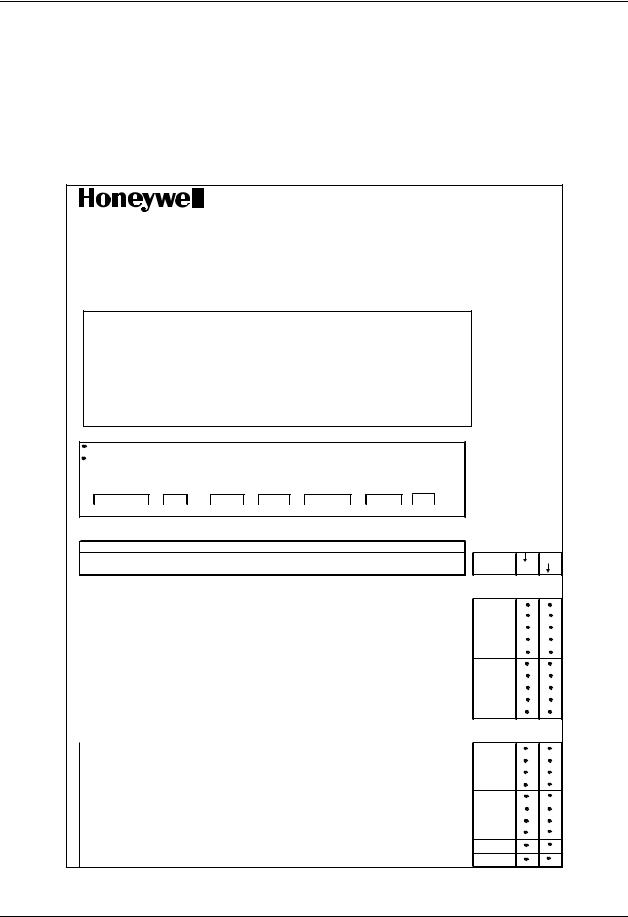
Installation
2.3 Model Number Interpretation
Introduction
Write your controller’s model number in the spaces provided below and circle the corresponding items in each table. This information will also be useful when you wire your controller.
Figure 2-1 Model Number Interpretation
51-51-16U-80 Issue 13 Page 1 of 3
UDC3200 Universal Digital Controller
Model Selection Guide
New! Easy To Use UDC3200 1/4 DIN Single Loop Controller
The UDC3200 Controller packs new powerful features while retaining all the simplicity and flexibility of the industry standard UDC3300 Controller. Many new optional features include:
-Enhanced Display
-Built-in infrared communications port for configuring with a Pocket PC or Laptop
-PC Based Configuration Tools
-Ethernet Communications
-Two Analog Inputs
-Accutune III, Fast/Slow, Heat/Cool
-Thermocouple Health Monitoring
Instructions
Select the desired key number. The arrow to the right marks the selection available.
Make the desired selections from Tables I through VI using the column below the proper arrow. A dot ( ) denotes availability.
) denotes availability.
Key Number |
I |
II |
III |
IV |
V |
VI |
_ _ _ _ _ _ - _ _ - _ _ _ _ - _ _ _ - _ _ _ _ _ - |
_ _ |
_ |
||||
KEY NUMBER - UDC3200 Single Loop Controller
Description
Digital Controller for use with 90 to 250Vac Power
Digital Controller for use with 24Vac/dc Power
TABLE I - Specify Control Output and/or Alarms
|
Current Output (4 to 20ma, 0 to 20 ma) |
Output #1 |
Electro Mechanical Relay (5 Amp Form C) |
Solid State Relay (1 Amp) |
|
|
Open Collector transistor output |
|
Dual 2 Amp Relays (Both are Form A) (Heat/Cool Applications) |
|
No Additional Outputs or Alarms |
Output #2 and Alarm |
One Alarm Relay Only |
#1 or Alarms 1 and 2 |
E-M Relay (5 Amp Form C) Plus Alarm 1 (5 Amp Form C Relay) |
|
Solid State Relay (1 Amp) Plus Alarm 1 (5 Amp Form C Relay) |
|
Open Collector Plus Alarm 1 (5 Amp Form C Relay) |
TABLE II - Communications and Software Selections
|
None |
|
Communications |
Auxiliary Output/Digital Inputs (1 Aux and 1 DI or 2 DI) |
|
RS-485 Modbus Plus Auxiliary Output/Digital Inputs |
||
|
||
|
10 Base-T Ethernet (Modbus RTU) Plus Auxiliary Output/Digital Inputs |
|
|
Standard Functions, Includes Accutune |
|
Software Selections |
Math Option |
|
|
Set Point Programming (1 Program, 12 Segments) |
|
|
Set Point Programming Plus Math |
|
Reserved |
No Selection |
|
|
|
|
Infrared interface |
Infrared Interface Included (Can be used with a Pocket PC) |
Selection Availability
DC3200
DC3201
C _
E _
A _
T _
R _
_ 0 _ B _ E _ A _ T
0 _ _ _
1 _ _ _
2 _ _ _
3 _ _ _
_ 0 _ _ _ A _ _ _ B _ _ _ C _ _
_ _ 0 _
_ _ _ R
March 2012 |
UDC3200 Universal Digital Controller Product Manual |
15 |
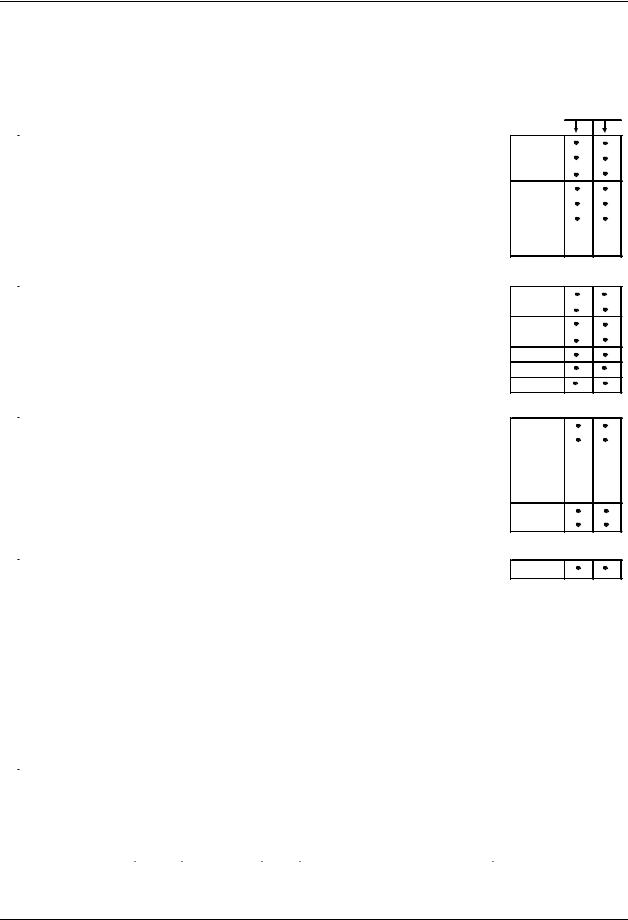
Installation
51-51-16U-80 Issue 13
Page 2 of 3
TABLE III - Input 1 can be changed in the field using external resistors
Input 1 |
TC, RTD, mV, 0-5V, 1-5V |
TC, RTD, mV, 0-5V, 1-5V, 0-20mA, 4-20mA |
|
|
TC, RTD, mV, 0-5V, 1-5V, 0-20mA, 4-20mA, 0-10V |
|
None |
Input 2 |
TC, RTD, mV, 0-5V, 1-5V, 0-20mA, 4-20mA |
TC, RTD, mV, 0-5V, 1-5V, 0-20mA, 4-20mA, 0-10V |
|
|
Slidewire Input for Position Proportional (Requires 2 Relay Outputs) |
|
Carbon, Oxygen or Dewpoint (Provides 2 Inputs) |
TABLE IV - Options
Approvals |
CE (Standard) |
|
CE, UL and CSA |
||
|
||
Tags |
None |
|
Stainless Steel Customer ID Tag - 3 lines w/22 characters/line |
||
|
||
Future Options |
None |
|
None |
||
|
None |
TABLE V - Product Manuals
|
Product Information on CD - All Languages |
|
|
English Manual |
|
Manuals |
French Manual |
|
German Manual |
||
|
||
|
Italian Manual |
|
|
Spanish Manual |
|
Certificate |
None |
|
Certificate of Conformance (F3391) |
||
|
||
TABLE VI |
|
No Selection |
None |
|
Availability |
|
|
DC 3200 |
3201 |
Selection |
|
|
1 _ _ |
|
|
2 _ _ |
|
|
3 _ _ |
|
|
_ 00 |
|
|
_ 10 |
|
|
_ 20 |
|
|
_ 40 |
a |
a |
_ 60 |
b |
b |
0 _ _ _ _
1 _ _ _ _
_ 0 _ _ _
_ T _ _ _
_ _ 0 _ _
_ _ _ 0 _
_ _ _ _ 0
0 _ E _ F _ G _ I _ S _
_ 0 _ C
0
ORDERING INSTRUCTIONS: These are provide as guidance for ordering such as those listed
1.Part numbers are provided to facilitate Distributor Stock.
2.Orders may be placed either by model selection or by part number.
3.Part numbers are shown within the model selection tables to assist with compatibility information.
4.Orders placed by model selection are systematically protected against incompatibility.
5.Compatibility assessment is the responsibility of the purchaser for orders placed by part number.
6.Items labeled as N/A are not available via the stocking program and must be ordered by model selection.
RESTRICTIONS
Restriction Letters |
Available Only With |
|
Not Available With |
|
Table |
Selection |
Table |
Selection |
|
a |
I |
EE |
|
|
I |
AA |
|
|
|
|
I |
R _ |
|
|
b |
III |
1 _ _ |
|
|
16 |
UDC3200 Universal Digital Controller Product Manual |
March 2012 |
